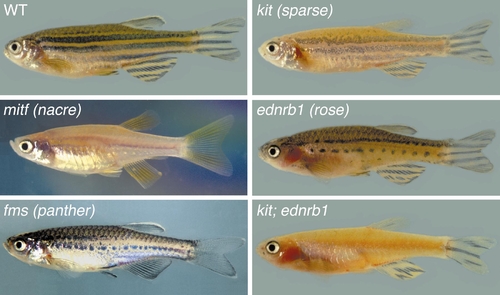Fig. 1
- ID
- ZDB-FIG-080514-24
- Publication
- Rawls et al., 2001 - How the zebrafish gets its stripes
- Other Figures
- All Figure Page
- Back to All Figure Page
|
Zebrafish mutants affect distinct classes of adult stripe melanocytes. Adult wild-type zebrafish (WT) have melanocyte stripes in the body, and in the caudal and anal fins. Adult homozygous mitfw2 (nacre) mutants [mitf (nacre)] lack all neural crest-derived melanocytes. Several zebrafish mutants develop around half the normal complement of adult body stripe melanocytes, lacking either early stripe melanocytes (ESMs) or late stripe melanocytes (LSMs). Homozygous fmsj4e1 (panther) mutants [fms (panther)] and ednrb1b140 (rose) mutants [ednrb1 (rose)] lack LSMs, while kitb5 (sparse) mutants lack ESMs and dorsal scale-associated melanocytes [kit (sparse)]. Adults homozygous for both kitb5 and ednrb1b140 lack all body stripe melanocytes (kit;ednrb1), demonstrating that the melanocyte classes absent in each of the respective single mutants are genetically distinct. Note that the kit;ednrb1 double mutants retain melanocyte stripes in the caudal and anal fins, revealing a third class of adult melanocytes. |
Reprinted from Developmental Biology, 240(2), Rawls, J.F., Mellgren, E.M., and Johnson, S.L., How the zebrafish gets its stripes, 301-314, Copyright (2001) with permission from Elsevier. Full text @ Dev. Biol.

